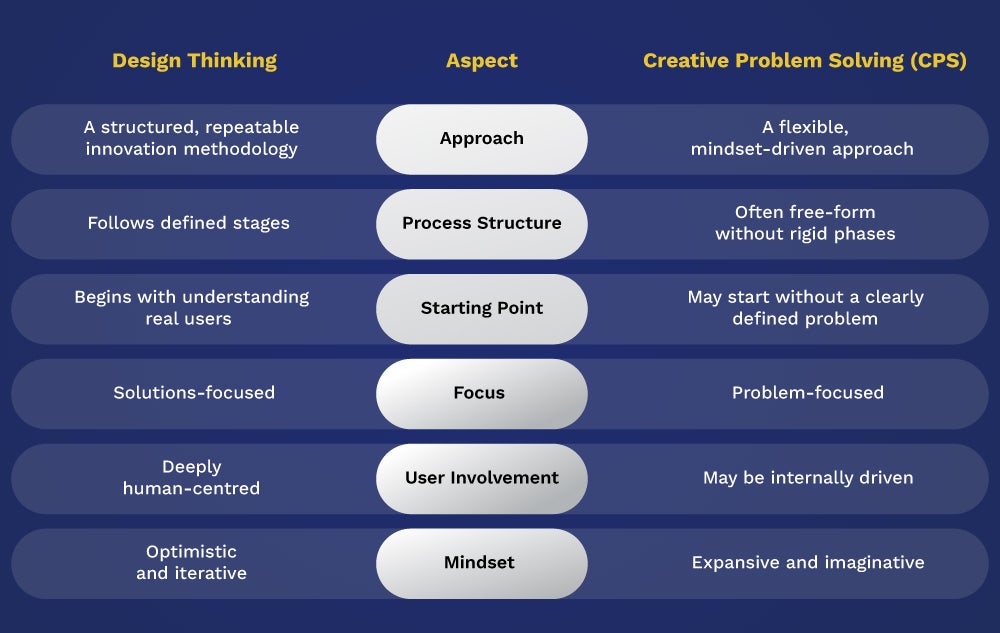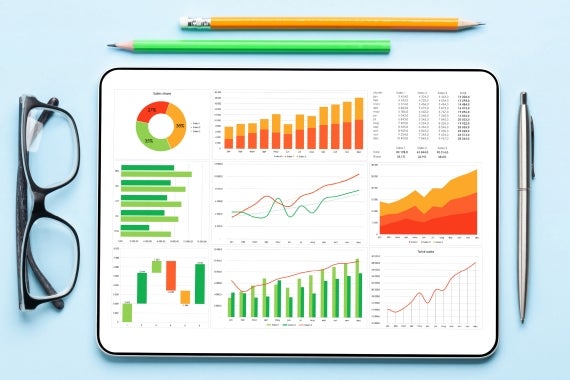Design Thinking: A Strategic Skill for Career Growth

In today's digital-first economy, where data-driven decision-making is crucial for staying ahead of the curve, companies are constantly on the lookout for talent that can skilfully combine rich data insights with creative ingenuity to drive business success. This is where design thinking emerges as a powerful tool, offering a human-centred method for addressing intricate challenges through empathy, experimentation, and teamwork.
What Is Design Thinking?
Design thinking is a user-centric problem-solving framework that prioritises the needs of users to create impactful solutions. It emphasises understanding the end-user and finding effective solutions, rather than focusing solely on the problem. By empathising with users’ experiences, motivations, and pain points, design thinkers redefine the true problem to address. This human-centred approach ensures ideas are relevant and resonate with customers.
Key Differences from Creative Problem-Solving
Design thinking differs from traditional creative problem-solving (CPS) in several ways:
- Structured Roadmap: Design thinking provides a clear roadmap for innovation. CPS often explores possibilities without a defined problem.
- Human-Centred: Design thinking always starts with real users and their context. CPS may focus more on internal brainstorming.
- Solutions-Focused: Design thinking emphasizes what could be done, encouraging optimism and forward motion. In contrast, CPS can sometimes dwell on the problem.
By understanding these differences, teams can choose the best approach for their innovation challenges.

4 Stages of the Design Thinking Process
A common model of the design thinking process includes 4 key stages. These stages form a cycle that teams can navigate repeatedly to refine their solutions.
1. Clarify (Empathise & Define)
In this first stage, the goal is to understand the user’s world and define the problem in human terms. The team conducts user research through various methods:
- Interviews
- Observations
- Surveys
All insights are later synthesised into a clear problem statement which then serves as a guiding star for the project.
2. Ideate
With a well-defined problem, the team enters brainstorming mode. They use ideation techniques to generate a wide range of ideas. At this stage, the focus is on:
- Quantity of ideas
- Encouraging wild ideas
- Withholding judgment
The goal is to explore unexpected, creative avenues without worrying about feasibility. This stage thrives on collaborative teamwork for richer ideas. By the end, the team narrows down the ideas to a few promising concepts that are likely to solve the defined problem.
3. Develop (Prototype & Test)
In the Develop stage, ideas become quick, low-cost prototypes. These can be:
- Sketches
- App demos
- Mock-ups
Users can interact with these rough versions, which help teams test what works and gather feedback. Based on responses, the team can refine the idea or revisit earlier stages. This test-and-refine cycle is key to shaping a solution that fits user needs.
4. Implement
In the last stage, the solution—be it a product, service, or process—is launched. The focus then shifts to the following to see if the solution works as intended while identifying new areas for improvement:
- Rollout
- Communication
- Tracking performance
But implementation isn’t the end; it’s part of a continuous cycle. Companies that embrace this loop of learning and refining often outperform competitors by staying closely aligned with user needs.
 6 Ways Design Thinking Can Help Accelerate Your Career
6 Ways Design Thinking Can Help Accelerate Your Career
Why invest time in learning design thinking? Simply put, it can be a game-changer for your professional growth. Whether you aim to excel in your current role or explore new career paths, here's how design thinking can unlock your true potential.
1. Create Solutions That Deliver Results
Design thinking helps you build products, services, or strategies that solve real customer problems. By focusing on user needs, you drive outcomes like stronger engagement, loyalty, and revenue.
2. Understand Customers More Deeply
This approach refines your empathy and user insight skills. You learn to observe behaviours, spot pain points, and design experiences that resonate. Whether you’re in marketing or product, this ability helps you tailor better solutions.
3. Work Smarter, Not Harder
Design thinking minimises time wasted on unproductive ideas. It encourages rapid prototyping and testing, conserving time, money, and resources.
4. Stand Out in the Job Market
In a competitive job landscape, this valuable skill distinguishes you from other candidates by highlighting your creativity, problem-solving skills, and user-centric mindset—qualities that employers seek across various sectors.
5. Think Beyond the Status Quo
Design thinking helps you break free from old habits and fixed thinking. It trains you to ask better questions, explore new angles, and reframe challenges. This mindset keeps you adaptable and open, and these are traits highly valued in fast-changing industries.
6. Lead Innovation in Any Team
When combined with leadership skills, design thinking becomes a powerful tool for driving change. It helps you guide teams through ideation, alignment, and execution to foster a culture of experimentation. If you're aiming for a leadership role, this is a skillset that sets you apart.
Lead With Innovation Through Design Thinking
With the rapid pace of technological advancements and shifting market trends, traditional approaches to problem-solving are no longer sufficient. When it comes to staying ahead of the curve, leaders must be equipped with the essential skills to devise creative solutions to real-world problems.
This pressing need for innovative leadership is the driving force behind the inclusion of the Design Thinking and Creative Problem Solving elective in Sunway University's Master of Business Analytics. Offered entirely online and part-time, this 100% online programme allows working professionals to balance their work and studies with ease, without having to sacrifice their career progression.
If you're eager to learn more, download your copy of the Master of Business Analytics programme guide here or reach out to our Education Counsellors to explore how this programme can help you achieve your career goals.


 6 Ways Design Thinking Can Help Accelerate Your Career
6 Ways Design Thinking Can Help Accelerate Your Career 


